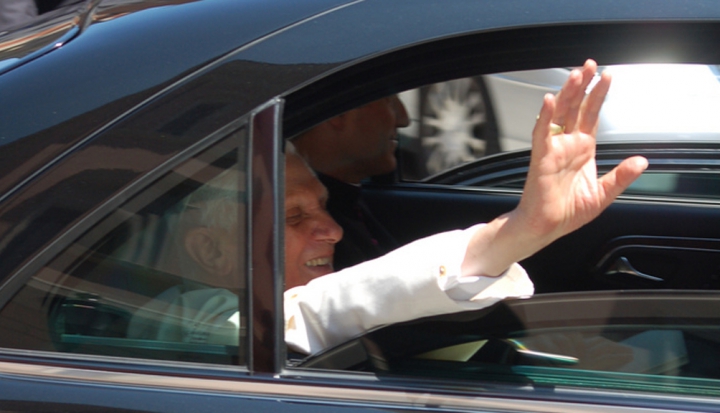Most popes take the job to their grave, but a few others before Benedict XVI have opted for early retirement.
As news of Benedict XVI’s resignation broke, Rome’s La Republica newspaper sent a reporter to gauge the reaction in the streets of the city. Some said they were speechless. Others thought the reporter was kidding. A historically minded interviewee recalled the most famous papal abdicator, saying, “This is just like Celestine V.” According to Dante’s Inferno, Celestine is spending eternity just outside of hell. Hell, Dante reasons, was for people who actually did things, and the only noteworthy thing about Celestine was that he quit.
If resigning the papacy was a crime, Celestine should have some company sitting and crying outside hell. Before 1294, the year of Celestine’s abdication, at least six popes had resigned, though the facts of several of these cases are difficult to ascertain.
The first case of papal tumult reportedly occurred shortly after St. Peter’s death. Clement I was Peter’s successor to lead the Christian community in Rome, but supporters of two other candidates, Linus and Anacletus, objected. Clement temporarily stepped aside, first allowing Linus to serve, then Anacletus. After Anacletus’ death around 90 A.D., Clement resumed his leadership.
Pontian, who served as pope during the third century, resigned upon learning he was to be arrested by Roman authorities and sentenced to hard labor in Sardinia for practicing Christianity. A few decades later, perhaps mindful of Pontian’s fate, Marcellinus took a different route when faced with pressure from the Roman government. During emperor Diocletian’s reign, Marcellinus allegedly offered sacrifices to the Roman gods. While this may have spared his life, it cost him his credibility among his fellow Christians, and Marcellinus resigned around 304 A.D.
When the threat of Roman persecution ended in the fourth century, instead of facing emperors who wanted to kill them, popes had to contend with emperors, kings, and aristocratic Roman families who endlessly meddled in church affairs.
The events that drove Martin I from office during the seventh century were unusual in that they stemmed from a genuine theological controversy. The church, particularly in Asia Minor, was wracked by an increasingly nasty debate over the divinity of Christ. The Byzantine emperor Constans II tried to settle the matter by forbidding anyone to discuss Christ’s divinity. Martin defied this edict and opened a synod to settle the debate. Constans responded by having an army invade Rome and drive Martin from office. Realizing he would likely die in exile, Martin reportedly consented to have a successor elected in his absence.
Far more typical were the cases of Benedict IX and Gregory VI. Scion of a powerful Roman family, Benedict was a 20-something layman with a violent temper and a reputation for hosting orgies when he succeeded his uncle, John XIX, in the papacy in 1032. In 1044, a revolt drove Benedict from Rome, and other contenders for the papal throne emerged.
One was another uncle of Benedict, Gregory VI. Genuinely concerned for the church’s well-being, Gregory attempted to restore order to Rome by paying Benedict to abdicate. Benedict took the money, and Gregory became pope. However, since he bought his office, some challenged Gregory’s legitimacy. Ultimately, the Holy Roman Emperor Henry III forced both men to relinquish their claims to the papacy.
Given the often sordid circumstances surrounding papal resignations, Celestine should get some credit for his dignified departure. Pietro del Morrone was an octogenarian hermit with a reputation for holiness when he was elected to serve as Celestine V. Woefully ill-prepared for the job—Celestine barely read Latin—he resigned after five months in office and without ever setting foot in Rome. On December 13, 1294, before an assembly of cardinals gathered in Naples, the pope read a statement announcing his resignation, swapped his papal vestments for a gray hermit’s habit, and resumed life as Pietro del Morrone.
Well, almost. Celestine’s successor, Boniface VIII, feared that having another properly elected pope at large, even though that pope had resigned, could prove a threat. Boniface had his predecessor placed under house arrest, and Celestine died a short while later.
In the saga of papal resignations, Celestine may well have had the last laugh. One more pope, Gregory XII, would resign after him, in 1415. Celestine, however, set the precedent that a pope could legitimately resign and another pope could legitimately be elected without bribery or bloodshed. While Dante may have placed him in hell, the church declared Celestine V a saint in 1313.
In 2009, an earthquake in the Italian city of L’Aquila badly damaged Santa Maria Collemaggio, the church that houses Celestine’s remains. During a trip to L’Aquila, Benedict XVI placed his pallium on Celestine’s tomb. At the time this papal gift was seen as a gesture of kindness toward a traumatized city. Now many are wondering if Benedict’s action signaled his own intention to follow in Celestine’s footsteps.
This article appeared in the April 2013 issue of U.S. Catholic (Vol. 78, No. 4, pages 24-25).













Add comment